|
 | Anglo Saxon History |  | |
| Roman Locations that have not been identified
and roads that just terminate
|
|---|
| |
|---|
| The reason for this page |
|---|
I hope on this page to show both Roman road that appear to stop and also Roman locations that no one has as yet
identified.
| | |
|---|
| Why I am using the high tide/sea level as 4.5 metres higher ▲ |
|---|
I have been working on the translations of Saxon Settlement names for about 20 years now and I think I can explain a lot
of the names by setting the high tide line on the maps to about 4.5 metres in Early Saxon/Late Roman times.
My logic for this is found on these pages:
Landscape - Was the sea level in Saxon times
at Pevensey 4 to 5 metres higher ?
Was the high tide in Saxon times 5 metres higher
? - the Wash
and a theoretical explanation of why which may or may not be correct
Landscape - High Tide changes in the last 2000 years
| | |
|---|
Roman roads that just appear to terminate inland ▲
|
|---|
The Roman European roads described are from Digital Atlas of the Roman
Empire and the UK ones are from our maps of Ivan D Margary taken
from his book 'Roman Roads in Britain'.
Please note that the darker shaded areas show the sea at approximately 4.5 metres above current levels, please note this
is an approximation as I don't have a way of accurately plotting this. To see a more accurate version please go to flood.firetree.net and choose 5 metres in the pull down.
| | |
|---|
Margary road M38 - Smallburgh to Denver ▲
|
|---|
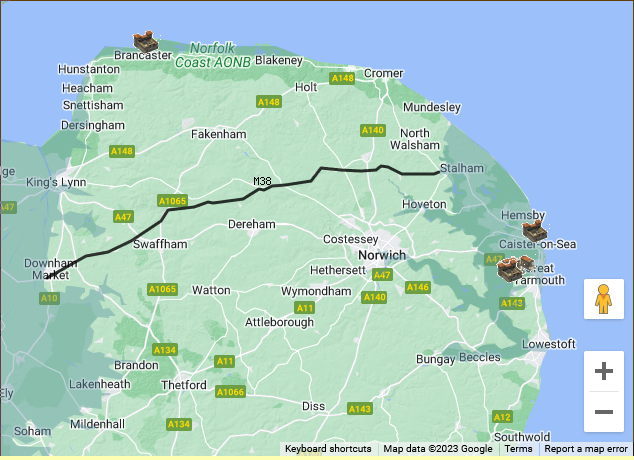 Margary describes the Smallburgh end of the road as
Margary describes the Smallburgh end of the road as
This east-west road has only recently been recognised as a major route, although part of it on Marsham Heath has long
been known. It appears to be the obvious eastward continuation of the Fen Road(25) from Durobrivae and Peterborough
through Denver to the east coast, perhaps to the Roman site at Caistor next Yarmouth, or to a port now destroyed by the
severe coastal erosion, but it has not yet been identified east of the river Ant at Smallburgh
If you accept that our description of the high tide level being about 4.5 metres higher in Roman times, then Smallburgh
would have been a port on the coast as shown in the Google map.
| | |
|---|
Margary M51 - Ilchester to Puriton ▲
|
|---|
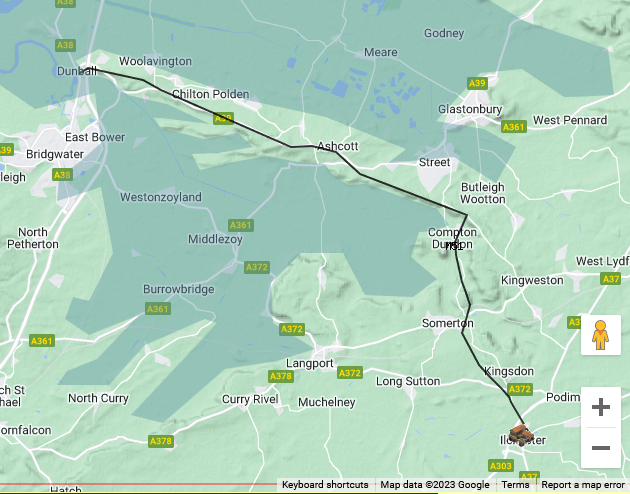 Margary describes the Puriton end of the road as
Margary describes the Puriton end of the road as
At Bawdrip after crossing the railway, it is lost for 1/2 mile but then reappears as a lane past the north side of
Knowle Hall grounds, and continuing straight along the ridge to its very tip at Dunhall, near Puriton, no doubt to
connect to a small harbour on the estuary of the river Parrett.
If you accept that our description of the high tide level being about 4.5 metres higher in Roman times, then Dunhall
would have been on the coast as shown in the Google map.
| | |
|---|
Margary M27 - Lincoln to Burgh Le Marsh ▲
|
|---|
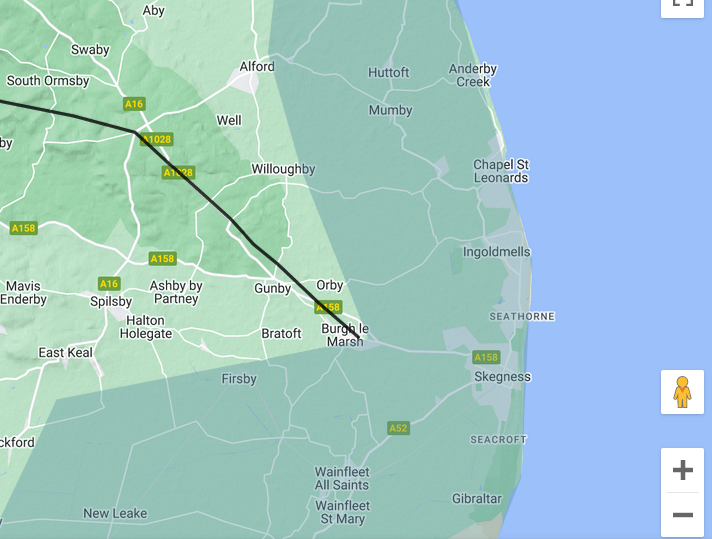 Margary describes the Burgh Le Marsh end of the road as
Margary describes the Burgh Le Marsh end of the road as
Then beyond Candlesby Hill a hedgerow in the same line marks it up to the east side of Welton vicarage, but beyond
this there is no trace, until on the north west outskirts of Burgh le Marsh, the lane leading back to Orby marks the
line for 1/2 mile into Burgh.
This is the last certain portion of the alignment, which if continued beyond Burgh would have crossed the marshes to
the coast.
If you accept that our description of the high tide level being about 4.5 metres higher in Roman times, then Burgh le
Marsh would have been on the coast as shown in the Google map
| | |
|---|
Margary M273 - Stixwould to Saltfleet ▲
|
|---|
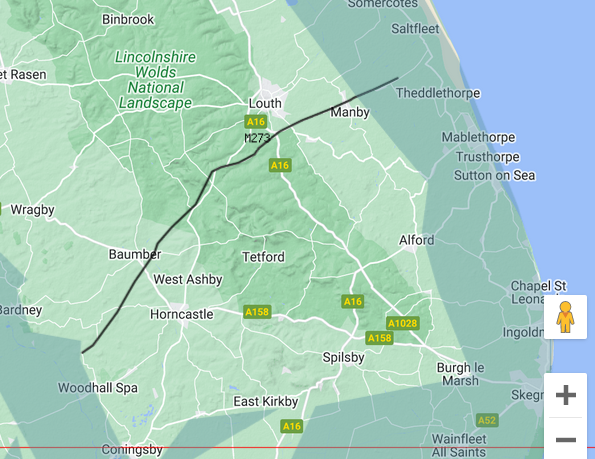 M273 Stixwould to Saltfleet
M273 Stixwould to Saltfleet
It was probably continued south-westward near Stixwould on the edge of the fens, and may have had a connection
through Woodhall Spa and North Kyme with the Sleaford road but this is uncertain.
This is the eastward description of this road.
If you accept that our description of the high tide level being about 4.5 metres higher in Roman times, then Stixwould
would have been on the coast as shown in the Google map
| | |
|---|
Margary M58b - Grantham(Saltersford) to Donington ▲
|
|---|
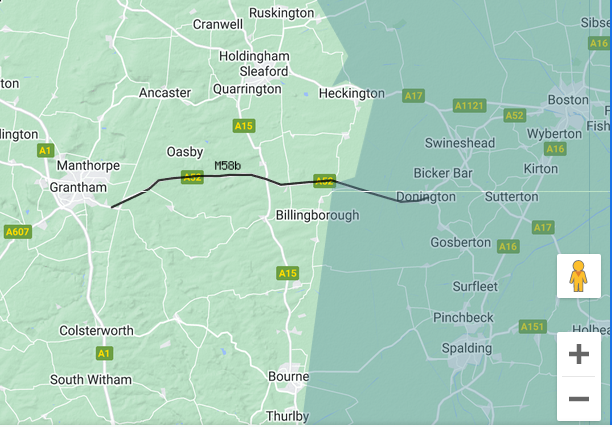 M58b Grantham(Saltersford) to Donington
M58b Grantham(Saltersford) to Donington
After passing Swaton, where it turns a little to the south-east, it crosses the belt of fen land and bears the name
Bridge End Causeway, reaching Donington just beyond, and no definite course has been traced onwards.
It would seem from our names research that a causeway was a raised road constructed so it was significantly higher that
the surrounding area.
If you accept that our description of the high tide level being about 4.5 metres higher in Roman times, then Donington
would have been on the coast as shown in the Google map
| | |
|---|
Margary M332 - Roudham Heath to Hockwold ▲
|
|---|
 M332 Roudham Heath to Hockwold
M332 Roudham Heath to Hockwold
The present road deviates through the village, but the line is continued by a hedgerow and footpath until, just
beyond, the present road resumes the line and continues very straight for 3 1/2 miles to Hockwold and through the
village right to the edge of the fenland area
If you accept that our description of the high tide level being about 4.5 metres higher in Roman times, then Hockwold
would have been on the coast as shown in the Google map
| | |
|---|
Margary M23b - Cambridge to Littleport ▲
|
|---|
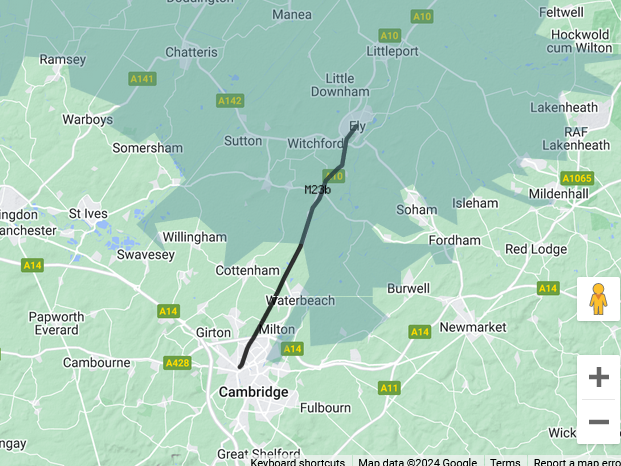 M23b Cambridge to Littleport
M23b Cambridge to Littleport
The Ely road returns to the line for the last 1/2 mile to the town, and it is likely that this line was followed by
the Roman road right on to Littleport, rather to the west of the centre of Ely
If you accept that our description of the high tide level being about 4.5 metres higher in Roman times, then Littleport
would have been in the sea as shown in the Google map
| | |
|---|
| And now some in Northern Europe ▲ |
|---|
| |
|---|
| Notitia dignitatum ▲ |
|---|
The Notitia Dignitatum (Latin for "The List of Offices") is a document of the Late Roman Empire that details the
administrative organization of the Western and the Eastern Roman Empire. It is unique as one of very few surviving
documents of Roman government, and describes several thousand offices from the imperial court to provincial governments,
diplomatic missions, and army units. It is usually considered to be accurate for the Western Roman Empire in the AD 420s
and for the Eastern or Byzantine Empire in the AD 390s.
These details are an extract from the Wikipedia entry for the Notitia dignitatum.
| | |
|---|
XXXVIII. Dux Belgicae secundae. ▲
|
|---|
This is the original latin from the Notitia dignitatum
Sub dispositione viri spectabilis ducis Balgicae secundae:
Equites Dalmatae, Marcis in litore Saxonico.
Praefectus classis Sambricae, in loco Quartensi siue Hornensi.
Tribunus militum Neruiorum, Portu Epatiaci.
Which translates into
Under the command of the handsome Duke of Balgica the Second:
Dalmatian horsemen, Marcus on the Saxon coast.
Commander of the Sambrian fleet, in place of Quartense or Hornes.
Tribune of the Nerui soldiers, Portu Epatiacus.
This is another extract from Wikipedia
The Notitia also includes two separate commands for the northern coast of Gaul, both of which belonged to the Saxon
Shore system. However, when the list was compiled, in c. 420 AD, Britain had been abandoned by Roman forces.
The first command controlled the shores of the province Belgica Secunda (roughly between the estuaries of the Scheldt
and the Somme), under the dux Belgicae Secundae with headquarters at Portus Aepatiaci
Marcae (unidentified location near Calais, possibly Marquise or Marck), garrisoned by the Equites Dalmatae. In
the Notitia, together with Grannona, it is the only site on the Gallic shore to be explicitly referred to as lying in
litore Saxonico.
Locus Quartensis sive Hornensis (probably at the mouth of the Somme), the port of the classis Sambrica ("Fleet of
the Somme")
Portus Aepatiaci (possibly Étaples), garrisoned by the milites Nervii.
Although not mentioned in the Notitia, the port of Gesoriacum or Bononia (Boulogne-sur-Mer), which until 296 was the
main base of the Classis Britannica, would also have come under the dux Belgicae Secundae
|
Map of Northern France and Belgium with the sea at 4.5 metres OD. ▲
|
|---|
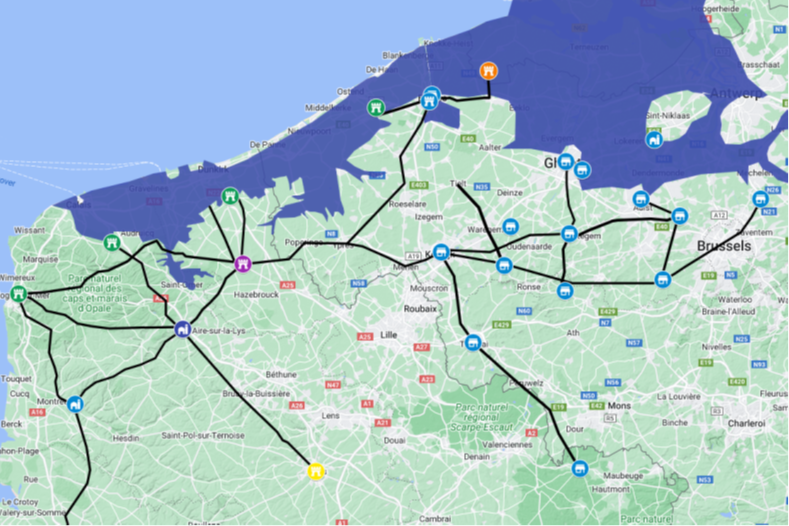
This map is derived from the Digital Atlas of the Roman Empire
From this map of Northern France and Belgium we can see that the coastline has changed significantly from Roman times,
this map also shows Roman roads that cannot be traced beyond the 4.5 metre high tide level.
Also from this map it would seem that Marcae was either at modern Ardres, Arques or Burgues, as these would all have
been on the coast.
|
|
|
|
|
| |
|
|
Local Interest
Just click an image |
|
|
|
|
|
|
|
|
|
|
|
|
| |
|
|